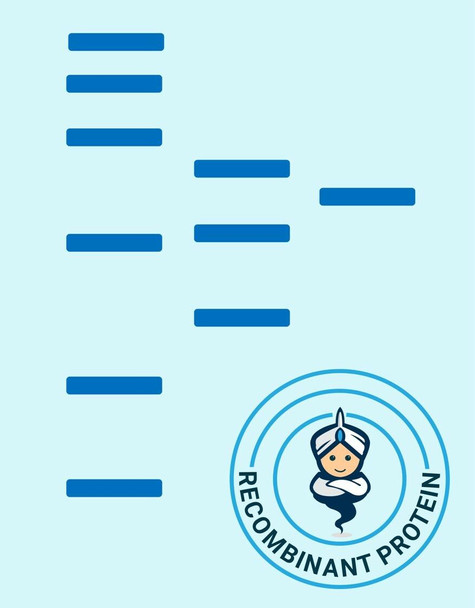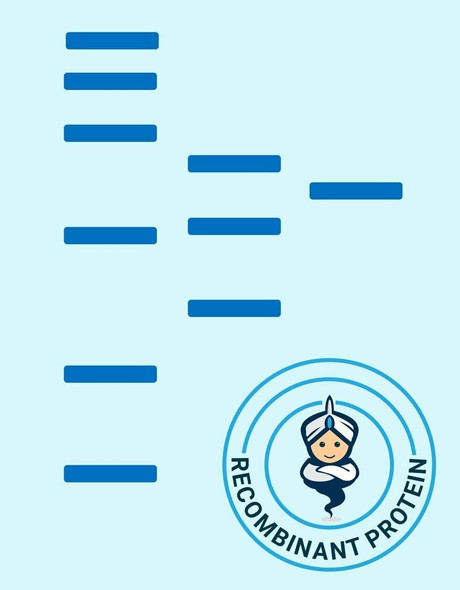Human FGF 2 Recombinant Protein (RPPB0206)
- SKU:
- RPPB0206
- Product type:
- Recombinant Protein
- Size:
- 10ug
- Species:
- Human
- Target:
- FGF 2
- Synonyms:
- Prostatropin
- HBGH-2
- HBGF-2
- FGF-2
- Source:
- Baculovirus Insect Cells
- Uniprot:
- P09038
Description
| Product Name: | Human FGF 2 Recombinant Protein |
| Product Code: | RPPB0206 |
| Size: | 10µg |
| Species: | Human |
| Target: | FGF 2 |
| Synonyms: | Prostatropin, HBGH-2, HBGF-2, FGF-2, FGF-b. |
| Source: | Baculovirus Insect Cells |
| Physical Appearance: | Sterile Filtered liquid formulation. |
| Formulation: | The sterile protein solution (0.5mg/ml) contains 20mM Tris pH=7.9, 100mM KCl, 1mM DTT and 20% glycerol. |
| Stability: | Store at 4°C if entire vial will be used within 2-4 weeks. Store, frozen at -20°C for longer periods of time. For long term storage it is recommended to add a carrier protein (0.1% HSA or BSA).Avoid multiple freeze-thaw cycles. |
| Purity: | Greater than 98.0% as determined by(a) Analysis by RP-HPLC.(b) Analysis by SDS-PAGE. |
| Amino Acid Sequence: | The sequence of the first five N-terminal amino acids was determined and was found to be Ala-Ala-Gly-Ser-Ile |
| Biological Activity: | The ED50, calculated by the dose-dependant proliferation of BAF3 cells expressing FGF receptors (measured by 3H-thymidine uptake) is <0.5 ng/ml, corresponding to a specific activity of 2MU/mg. |
Basic fibroblast growth factor is a member of the fibroblast growth factor (FGF) family. FGF family members possess broad mitogenic and cell survival activities, and are involved in a variety of biological processes, including embryonic development, cell growth, morphogenesis, tissue repair, tumor growth and invasion. This protein functions as a modifier of endothelial cell migration and proliferation, as well as an angiogenic factor. It acts as a mitogen for a variety of mesoderm- and neuroectoderm-derived cells in vitro, thus is thought to be involved in organogenesis. Three alternatively spliced variants encoding different isoforms have been described. The heparin-binding growth factors are angiogenic agents in vivo and are potent mitogens for a variety of cell types in vitro. There are differences in the tissue distribution and concentration of these 2 growth factors.
Fibroblast Growth Factor-2 Human Recombinant (FGF-2) produced in Sf9 insect cells is a single, glycosylated, polypeptide chain containing 155 amino acids and having a molecular mass of 17353 Dalton.The FGF-basic is purified by proprietary chromatographic techniques.
| UniProt Protein Function: | FGF2: Plays an important role in the regulation of cell survival, cell division, angiogenesis, cell differentiation and cell migration. Functions as potent mitogen in vitro. Monomer. Homodimer. Interacts with FGFR1, FGFR2, FGFR3 and FGFR4. Affinity between fibroblast growth factors (FGFs) and their receptors is increased by heparan sulfate glycosaminoglycans that function as coreceptors. Interacts with CSPG4, FGFBP1 and TEC. Found in a complex with FGFBP1, FGF1 and FGF2. Expressed in granulosa and cumulus cells. Expressed in hepatocellular carcinoma cells, but not in non- cancerous liver tissue. Belongs to the heparin-binding growth factors family. 4 isoforms of the human protein are produced by alternative initiation. |
| UniProt Protein Details: | Protein type:Activator; Motility/polarity/chemotaxis Chromosomal Location of Human Ortholog: 4q26 Cellular Component: extracellular space; extracellular region; nucleus Molecular Function:heparin binding; protein binding; ligand-dependent nuclear receptor transcription coactivator activity; growth factor activity; cytokine activity; chemoattractant activity; fibroblast growth factor receptor binding Biological Process: extracellular matrix organization and biogenesis; wound healing; nerve growth factor receptor signaling pathway; somatic stem cell maintenance; activation of MAPK activity; positive regulation of transcription, DNA-dependent; chemotaxis; signal transduction; hyaluronan catabolic process; growth factor dependent regulation of satellite cell proliferation; positive regulation of MAP kinase activity; positive chemotaxis; positive regulation of cell proliferation; embryonic morphogenesis; positive regulation of cardiac muscle cell proliferation; epidermal growth factor receptor signaling pathway; nervous system development; phosphoinositide-mediated signaling; fibroblast growth factor receptor signaling pathway; positive regulation of cell fate specification; positive regulation of blood vessel endothelial cell migration; positive regulation of phosphoinositide 3-kinase activity; negative regulation of blood vessel endothelial cell migration; regulation of angiogenesis; positive regulation of angiogenesis; organ morphogenesis; cell migration during sprouting angiogenesis; ureteric bud branching; release of sequestered calcium ion into cytosol; positive regulation of cell division; Ras protein signal transduction; insulin receptor signaling pathway; phosphatidylinositol biosynthetic process; innate immune response; positive regulation of transcription from RNA polymerase II promoter; positive regulation of endothelial cell proliferation; inositol phosphate biosynthetic process |
| NCBI Summary: | The protein encoded by this gene is a member of the fibroblast growth factor (FGF) family. FGF family members bind heparin and possess broad mitogenic and angiogenic activities. This protein has been implicated in diverse biological processes, such as limb and nervous system development, wound healing, and tumor growth. The mRNA for this gene contains multiple polyadenylation sites, and is alternatively translated from non-AUG (CUG) and AUG initiation codons, resulting in five different isoforms with distinct properties. The CUG-initiated isoforms are localized in the nucleus and are responsible for the intracrine effect, whereas, the AUG-initiated form is mostly cytosolic and is responsible for the paracrine and autocrine effects of this FGF. [provided by RefSeq, Jul 2008] |
| UniProt Code: | P09038 |
| NCBI GenInfo Identifier: | 261260095 |
| NCBI Gene ID: | 2247 |
| NCBI Accession: | P09038.3 |
| UniProt Secondary Accession: | P09038,O00527, P78443, Q16443, Q5PY50, Q7KZ11, Q7KZ72 Q9UC54, Q9UCS5, Q9UCS6, A4LBB8, |
| UniProt Related Accession: | P09038 |
| Molecular Weight: | |
| NCBI Full Name: | Fibroblast growth factor 2 |
| NCBI Synonym Full Names: | fibroblast growth factor 2 (basic) |
| NCBI Official Symbol: | FGF2 |
| NCBI Official Synonym Symbols: | BFGF; FGFB; FGF-2; HBGF-2 |
| NCBI Protein Information: | fibroblast growth factor 2; prostatropin; heparin-binding growth factor 2; basic fibroblast growth factor bFGF |
| UniProt Protein Name: | Fibroblast growth factor 2 |
| UniProt Synonym Protein Names: | Basic fibroblast growth factor; bFGF; Heparin-binding growth factor 2; HBGF-2 |
| Protein Family: | Fibroblast growth factor |
| UniProt Gene Name: | FGF2 |
| UniProt Entry Name: | FGF2_HUMAN |










